Article
World War II Shipwrecks in Truk Lagoon: The Role of Interest Groups
by Bill Jeffery
Chuuk advertises itself as an idyllic tropic paradise in the Pacific Ocean. What sets Chuuk apart from its neighboring islands is its underwater attractions. "The Chuuk lagoon is the final tomb for more than 100 ships, planes, and submarines—the legacy of a fierce World War II battle between the Japanese Imperial Fleet and Allied [primarily the United States] carrier attack planes." As a tourist website reports, "It is a rare opportunity to find so many shipwrecks so close together and so completely intact." These simple declarations belie the complexity behind the reality. The World War II material culture constitutes the single largest tourism resource for Chuuk, and the shipwrecks are under increasing pressure and threat.
Truk (now called by its traditional name, Chuuk) was the Imperial Japanese Navy's Fourth Fleet Base from 1939 and its Combined Fleet Base for nearly two years during World War II. The United States considered Truk the "strongest naval base in the Pacific with the exception of Pearl Harbor."(1) On February 17 and 18, 1944, the United States began an aerial bombing campaign that effectively took the base out of the war within a few months, and, by ongoing bombing and submarine activity, kept it out of the war to the end.(2)
Several groups are vitally interested in Chuuk's World War II underwater historic sites. In the decades after the war's end, the Chuukese found that a growing number of foreign divers were drawn to the sites, to dive and photograph large shipwrecks in a tropical environment and, for some, to collect World War II artifacts.(3) Dive activities greatly expanded from 1970 to 2000 and influenced how the Chuukese regard and treat the sites today—as destinations for diving tourists. Japanese and American tourists, however, view them as part of the "Truk Lagoon battleground," and visit Chuuk to pay respects to fallen colleagues and relatives, renew contacts established during the war, or dive the shipwrecks.
Understanding this heritage and its interest groups is an important consideration in managing this material culture. The Chuukese government and portions of the local community are interested in the underwater sites because of the financial rewards from tourism, which has transformed these former war machines into a vital economic asset. Does this make the sites less important or less significant as historic resources to these groups?
Given the importance of the underwater sites, it is surprising that there have been no major academic or theoretical studies of the World War II underwater cultural heritage in Truk Lagoon, and only two previous management investigations.(4) This essay addresses the issues facing these sites and their multiple meanings, and suggests possible directions for their management.
Location and Economy of Chuuk
Chuuk is one of four states—with Yap, Pohnpei, and Kosrae—in the Federated States of Micronesia. Chuuk is located approximately 7° north of the Equator and at 152° east longitude—approximately the same as the east coast of Australia.(Figure 1) This "sea of islands" with a total land mass of 270 square miles in a current economic exclusion zone of 1,158,310 square miles make up, in combination with the Republic of Palau, the Caroline Islands. Together with the other island groups, the Republic of the Marshall Islands, Guam, the Commonwealth of the Northern Mariana Islands, the Republic of Nauru, and the Republic of Kiribati, they form a region that Europeans refer to as Micronesia, and are distinct from the two other Pacific Island regions, Polynesia and Melanesia.
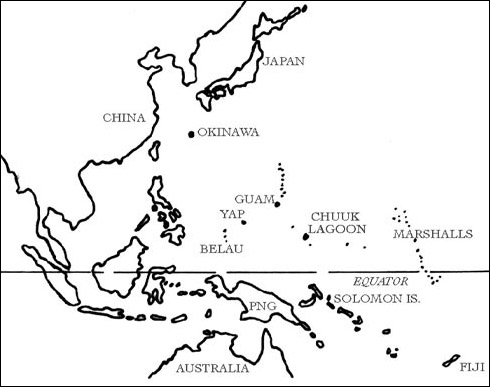 |
Figure 1. Chuuk is one of the four states of the Federated States of Micronesia. (Courtesy of Nature Art, South Australia.) |
Chuuk consists of 19 "high" islands inside Truk Lagoon, 10 atolls, and 225 "low" coralline islands many of which are outside the lagoon. The high islands are the peaks of volcanic mountains, with a total mass above water of approximately 35 square miles. The lagoon is approximately 40 miles in diameter and is bounded by a barrier reef enclosing approximately 820 square miles.(Figure 2)
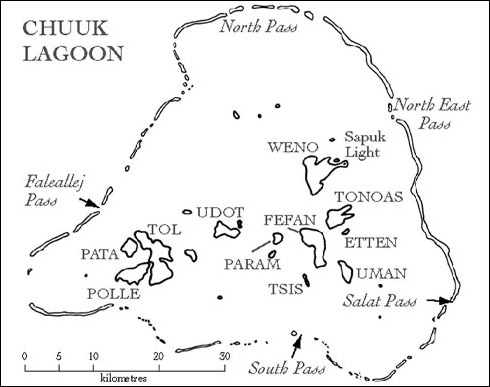 |
Figure 2. Chuuk consists of 19 "high" islands inside Truk Lagoon. (Courtesy of Nature Art, South Australia.) |
The islands are fringed with mangroves that support an abundant and diverse marine life. The fertile high islands contain native trees and plants including breadfruit, coconuts, mango, banana, and taro that, in association with fish, have supported a subsistence lifestyle for the Chuukese for many years. A significant increase in the population, from 9,185 in 1946 to 60,000 in 2002, and the change to a cash-based economy resulted in less reliance on subsistence living and more on imported food. Government employment is the largest source of income in Chuuk.(5) Commercial fishing provides the biggest export commodity. Tourism is a major source of revenue, with the World War II shipwrecks the most important tourist attraction. Approximately 3,000 tourists annually dive the shipwrecks (although in 1996 nearly 10,000 tourists visited Chuuk), which are regarded as the "world's largest collection of artificial reefs"(6) and "a World War II enthusiast's dream."(7)
Brief History of Chuuk
People have inhabited Chuuk for about 2,000 years.(8) The first Europeans, the Spanish, arrived in 1565, 34 years after Magellan passed by on his first voyage.(9) Spanish, English, French, American, Russian, and German explorers, traders, whalers, and missionaries subsequently visited the islands, but the Chuukese were found to be hostile, and it was not until 1886 that the Spanish established a presence and rule over Micronesia, including Chuuk. After the Spanish-American War of 1898, an arrangement among Spain, Germany, and the United States allowed Micronesia, except for Guam, to be purchased by Germany from the United States for about $4.2 million.(10) At the beginning of World War I, Japan seized the islands in a secret and controversial pact with Great Britain to counter the German presence in the Pacific.
Japanese traders traveled to Micronesia beginning in the 1880s as part of the Meiji Restoration initiatives. Over the next 50 years, until the beginning of World War II, "the Japanese cultivation of the islands had wrought a minor agricultural revolution [in Micronesia]. Although it had but small impact on the empire as a whole, the agricultural activities contributed to the general prosperity of the colony and changed the landscape of the larger islands."(11) In 1914, Japan formally occupied Micronesia and considered it a mandated area under the League of Nations in 1919.
However, through a policy of assimilation, alienation of Micronesians from their land, and intensive migration, the Indigenous population soon found themselves to be "strangers in their own land."(12) The Japanese navy controlled Micronesia from 1914 to 1922 from its headquarters on Dublon, now called Tonoas, in Chuuk. In 1922, a civilian administration based in Koror, Palau (now Belau), took charge and began aggressively using Micronesia to suit Japan's needs for economic and strategic expansion.(13) Japanese immigrants soon out-numbered Micronesians. In 1935, there were 50,000 Japanese throughout Micronesia; in 1942, there were 96,000, while the population of native Micronesians remained approximately 50,000.
By 1937, the Japanese navy was again in control in Micronesia, directing the civilian government in establishing airstrips and sea-plane bases. Truk Lagoon was considered one of the greatest sites for a naval base in the Pacific because of its deep waters and natural protection. The base played a major role in the Japanese expansion in the Pacific, starting with the bombing of Pearl Harbor on December 7, 1941.
During 1944 and 1945, the United States and its allies bombed Japanese facilities and vessels in Truk Lagoon, sinking more than 50 ships and destroying over 400 aircraft. At the conclusion of World War II, the Japanese departed Micronesia and the United States was designated as trustee by the United Nations. The administration of Micronesia, called the Trust Territory of the Pacific Islands, was assigned to the United States Navy until 1951 when the U.S. Department of the Interior took over. Over the next 35 years, an agreement on the independence of what became known as the Federated States of Micronesia was negotiated through a system of "Compacts of Free Association" between the United States and the Federated States. Other regions of Micronesia developed separate arrangements with the United States.
As a result of the foreign presence in Micronesia, its people can trace their ancestry to many nations, particularly the Japanese. Many traditional ways of life have changed forever. The country has been left with the remains and scars of occupation and World War II. Lin Poyer and her colleagues Suzanne Falgout and Laurence Marshall Carucci sum it up well: "The war forced a rethinking of cultural values, and it expanded islanders' knowledge of global military, political, and economic realities. World War II in Micronesia meant, in short, both terrible suffering and momentous change. Nothing would ever be the same again."(14)
Shipwrecks in Truk Lagoon
On February 4, 1944, a United States reconnaissance flight over Truk Lagoon observed nearly 60 ships, including the super battleship Musashi, the flagship of the Japanese navy; 2 aircraft carriers; 4 heavy cruisers; 3 light cruisers; 9 destroyers; 2 submarines; and over 30 tanker, repair, and transport ships.(15) The reconnaissance flight alerted the Japanese commanders to a possible United States attack and, as a result, most of the fleet departed for Palau the following week, leaving the transport ships behind to unload cargo.
The United States carried out two major air attacks on Truk, February 17 and 18, and April 30 and May 1, 1944. Attacks by B-24 and B-29 aircraft continued every few days until August 1945, dropping a total of 6,878 tons of bombs over the 18-month "blockade" of the Truk base. The loss of human life was considerable. Over 4,000 Japanese, 120 Chuukese, 30 Americans, 2 British, and several other nationals, including those from Nauru, Okinawa, and Korea, were killed or wounded as a result of the bombardment.(Figure 3)
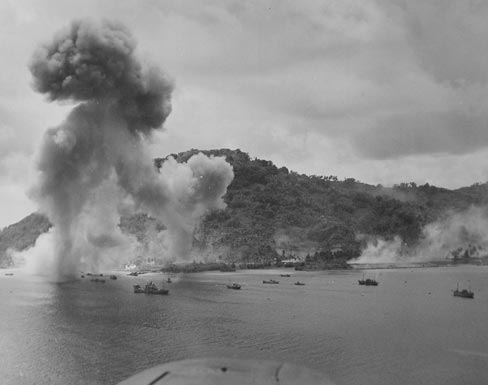 |
Figure 3. The bombing of Tonoas, Truk Lagoon, started in February 1944 and continued until August 1945. (Courtesy of Micronesian Seminar, Pohnpei.) |
The 51 ships sunk in Truk Lagoon include a group of 8 warships, comprised of 4 submarine chasers (130-420 tons), one submarine of 1,785 tons, 2 destroyers (each approximately 1,500 tons), one 935-ton patrol boat, and some smaller landing craft; 39 armed transport ships and tankers ranging in size from a few hundred tons to the 11,614-ton submarine tender Heian Maru (the largest ship in the lagoon); the 8,614-ton armed transport Kiyosumi Maru (which is representative of the 39 transport ships sunk); and 3 tugs.(16)(Figure 4) This list does not include the many smaller craft reported sunk.(17)
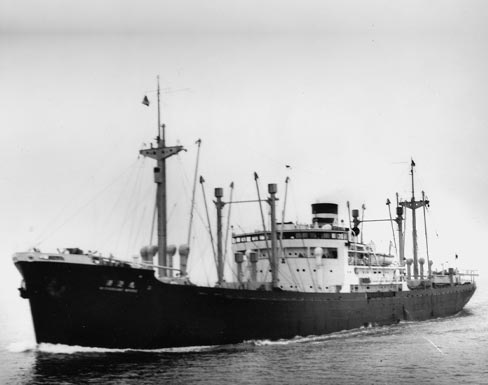 |
Figure 4. The Kiyosumi Maru is representative of the 39 armed transports sunk during the bombing of Truk Lagoon. (Courtesy of the National Maritime Museum, Greenwich, United Kingdom.) |
Many of the ships were anchored and unloading their cargo of oil, tanks, sea mines, vehicles, aircraft, and other war machinery, foodstuffs, alcohol, and medicines. The ships included the Fujikawa Maru, a 6,938-ton armed transport that still contains "zero" aircraft (the Japanese nickname given to its successful single-engine fighter plane, which the Americans codenamed a "zeke") in its holds (Figures 5 and 6); the Shinkoku Maru, a 10,020-ton oil tanker that assisted the Japanese fleet that struck Pearl Harbor; and the 10,437-ton armed transport, Aikoku Maru, that sank after a huge explosion and killed over 730 soldiers and crew. Destroyers and other ships attempting to flee the bombing sank near the passages through the encircling reef.
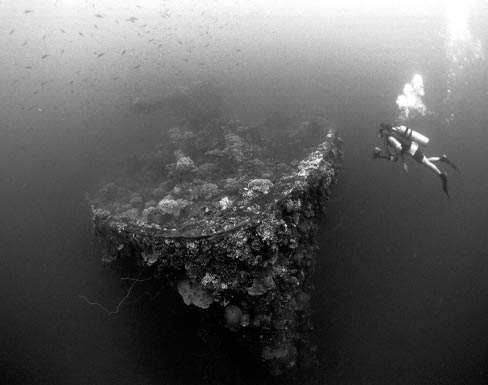 |
Figure 5. A view of the Fujikawa Maru shows its bow and bow gun on the deck. (Courtesy of Greg Adams, South Australia.) |
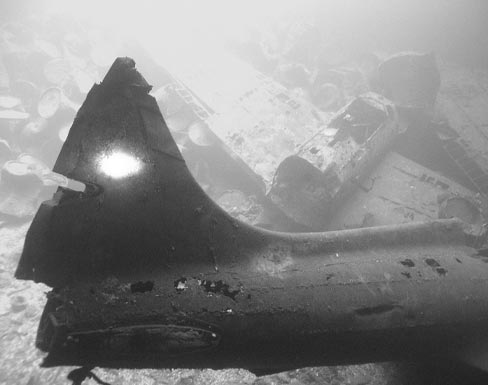 |
Figure 6. This view illustrates part of a "claude" (in the foreground) and a "zero" aircraft behind in the hold of the Fujikawa Maru. (Courtesy of the author.) |
Aircraft in Truk Lagoon
The remains of nine Japanese and one American World War II aircraft have been found in Truk Lagoon.(18) During the bombing campaign, nearly 450 planes were lost, including 416 Japanese aircraft (the majority of which were destroyed on the ground before take-off), 26 United States naval aircraft (including helldivers, hellcats, kingfishers, avengers, and a Douglas SBD-5 Dauntless), several British planes (a British carrier was attacked in June 1945), and 5 or 6 U.S. Air Force B-24s.(19) Japanese aircraft found inside the lagoon include zero fighters, dive bombers, reconnaissance aircraft, a larger two-engine bomber, and a four-engine flying boat.
Previous Studies Related to Chuuk's Cultural Heritage
A majority of the studies of Chuuk and the Federated States have focused on the anthropology, ethnography, and archeology of the Indigenous Micronesians.(20) Although several studies address the history of foreign powers associated with Chuuk,(21) little work has been devoted to the Spanish, German, and American material culture. Most work on "foreign" material culture has been carried out on the Japanese-period sites. In his study, Duane Colt Denfield found that "Truk is rich in World War II sites. It has in situ as many guns as all of Europe."(22)
A number of studies have addressed the impact of World War II on the Indigenous Pacific Islanders,(23) reporting that "those who experienced the intense suffering during the Japanese military buildup and the American campaign describe it as the greatest hardship they ever endured."(24) For World War II underwater cultural heritage, there are several "popular" texts(25) and a few consultant reports,(26) but no scholarly studies.
Current Status of the Sites
Although some salvage was carried out on the shipwrecks a few years after the war, and the effects of storms and people have taken their toll, the shipwrecks are essentially intact and still contain much of their cargo. Their environment has helped maintain the integrity of the ships; many are in 100-200 feet of water and protected by the reef from the effects of currents, winds, and ocean swells. The shipwrecks attract colorful and diverse marine life, causing them to be called "one of the great undersea wonders of the world."(27)
The shipwrecks and aircraft located in Truk Lagoon are protected under Chuukese, Federated States, and United States law.(28) The United States has designated the "Japanese Fleet" or "Chuuk (Truk) Lagoon Monument" a National Historic Landmark and listed it in the National Register of Historic Places. Under Chuukese and Federated States designations, it is illegal to interfere with these sites, punishable by fine or imprisonment. Federated States legal protection covers all artifacts on land and underwater that are older than 30 years. Primarily designed to manage diving on the shipwrecks, Chuuk law protects only Japanese war material below high water, and does not address American war material.
The Chuuk government is responsible for managing the Japanese wrecks, a task made more complex due to the lack of baseline data, overlapping jurisdiction among Chuuk government agencies, conflicting priorities for available funding and staff (an estimated $90,000 is raised each year from dive permits), inconsistent enforcement, insufficient public interpretation, and foreign management systems in a society with different values and priorities.
An example of the management difficulty is the recent discovery of a shipwreck in Truk Lagoon. The Sapporo Maru was located during a 2002 side-scan sonar survey conducted by Jeremy Green from the Western Australian Maritime Museum and the author as part of a Historic Preservation Fund-supported project.(29) (Figure 7) After diving the shipwreck and verifying its identity, the ship's bell was found in position on the bridge. However, within 24 hours, the bell was gone. Police discovered that the bell was removed by a dive guide and hidden on site. The police concluded that this was not an illegal act because the bell was not removed from the site, although the bell had been moved in a way that damaged that part of the ship.
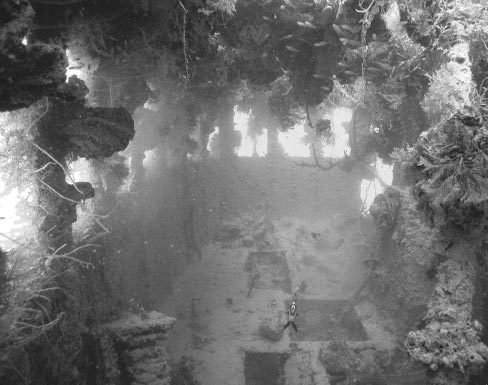 |
Figure 7. The Sapporo Maru was located during a 2002 side-scan sonar survey of shipwrecks. (Courtesy of Jeremy Green, Western Australia.) |
This act was seen by some as a way to safeguard important parts of the shipwrecks. A ship's bell, made of brass and engraved with the name of the ship, would be "the prize" for many divers seeking souvenirs. Residents know that trafficking in shipwreck artifacts occurs, and fear that this bell, reported to be the last in situ from the Truk Lagoon shipwrecks, could be lost. The current location of the bell is unknown, but the bell is rumored to still be on the Sapporo Maru, and efforts to have the bell turned over to the Chuuk Historic Preservation Office have proved unsuccessful.(30)
Tourists have been diving the shipwrecks and aircraft for 30 years and the wrecks show signs of wear and tear. Made of iron, steel, or aluminum and located in a marine environment, the shipwrecks' and aircrafts' current state of integrity was studied by Ian MacLeod as part of another Historic Preservation Fund-supported project during the first-ever corrosion survey of the sites in 2002.(Figure 8) Corrosion surveys are important to predicting the rate of corrosion, and perhaps collapse, of the sites. From his initial survey, MacLeod found: "Based on this provisional estimate of perforation times, many of the wrecks in Chuuk Lagoon will retain their existing integrity for only the next ten to fifteen years before they begin to undergo significant collapse. This has major implications for the management of the sites and for the safety of divers undertaking penetration dives."(31) It also has major implications for any fuel and oil in the bunkers of the ships, which if released in an uncontrolled manner could lead to grave environmental consequences.
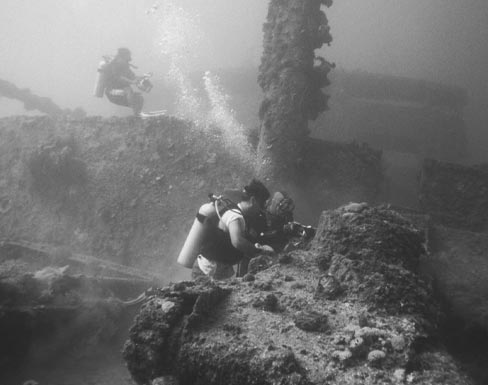 |
Figure 8. Ian MacLeod and Andy Viduka took corrosion measurements on a tank on the deck of the Nippo Maru in April 2002. (Courtesy of the author.) |
Other issues include artifacts that are removed to the decks for better photography; unintentional damage to the ship's structure; and the effect of divers' bubbles on accelerating corrosion and causing the release of fuel. Years of poor mooring practices have also taken their toll on the shipwrecks' integrity. While the live-aboard charter operators established and funded their own moorings on some sites, more are needed, and better practices are required for the smaller boats. The shipwrecks also contain munitions, some of which are used to make bombs for "dynamite fishing." Explosions damage nearby flora and fauna and the shipwrecks themselves.
Typhoons constitute another impact that is known, but has not been studied. The marine life and material culture located at depths of more than 60 feet have been disturbed from storms and typhoons, renewing corrosion and destroying fragile artifacts.
Significance of the Underwater Cultural Heritage Sites
Understanding the significance of cultural heritage sites is the most important management tool. Information should be gathered from the point of view of the local community and preservation practitioners, given that they will have the most impact on the sites' management. The significance of the World War II underwater cultural heritage sites to the Chuukese has never been clearly analyzed, hence the need for this research. Dirk Spennemann states that—
The Pacific Cultures are societies founded and rooted in oral traditions and oral histories. Tangible remainders of the past are of lesser importance, if at all. Thus, for many Pacific Islanders the historical Second World War remains signified little and if they did, they were reminders of that painful period. The entire period would have been repressed, or the negative images ignored and forgotten by many, were it not for all those who come to see just these sites.(32) |
In a different view of this issue, Geoffrey Miles White and Lamont Carl Lindstrom state, "World War II has sedimented into an intense—if narrow—band in the stratigraphy of social and individual histories [of many Pacific Islands]."(33) Lin Poyer and her colleagues assert that "Physical mementos of war hold little historical interest for most Micronesians, who may use them for practical value." They add, "Micronesian nations, however, have recognized the cultural importance of the Pacific war by sponsoring locally produced videos," and "The favorite film at the Truk Trading Company movie theater in the mid-1950s was the documentary 'The Bombing of Truk.'" The authors based this assessment on oral histories from over 300 Micronesian survivors. Lin Poyer and her colleagues have written—
Our project is one of the most recent to benefit from Micronesians' concern about the war and perpetuation of its memory. We received whole hearted assistance from every level of government and from the people we interviewed. They want to preserve this history and to correct the imbalance that makes Islanders nearly invisible in American and Japanese accounts of the Pacific war. Their desire to assume a more visible role in the history of the war is expressed in musings about construction of their own war memorials, though only Guam and Saipan now preserve memorials and parks devoted to Micronesian experiences.(34) |
One approach to understanding how the submerged sites are regarded by the Chuukese may be to examine how World War II sites on land are viewed. Are there differences in their treatment that can be attributed to the site's significance? Terrestrial sites are essentially left untouched, letting the jungle reclaim much of the cleared land and structures, or accessed as Chuukese homes. The World War II shipwrecks and aircraft are promoted as a diving attraction, and yet the terrestrial sites are equally numerous and many intact, but are not similarly promoted as tourist destinations.
What factors influence this treatment? Factors could include the suffering that resulted from the bombing, the occupation by the Japanese, and the need of the Chuukese to forget this painful period in their history. In his study of Chuukese views of a Chuukese-Japanese site and a Japanese World War II memorial on Fefan—one of the lagoon's major islands where the surrounding landscape has been ignored by the Chuukese—Paul Rainbird stated, "…a landscape with its associated remembrances may be intensified by its abandonment, by its discontinuity in its use. In fact, the abandoned landscape may be as much a memorial as is the structure erected for the purpose by the Japanese."(35) During a survey of terrestrial sites on Tonoas with the mayor and chiefs, this author found that the Japanese war sites were reminders to the Chuukese of how they suffered during the war and how some Chuukese lost their lives during the establishment of these facilities.(36) An emotional attachment to the sites was apparent as well as no great desire to change their status quo through site conservation, restoration, or promotion.
The shipwrecks are also associated with death and destruction—destruction of Japanese ships and the death of Japanese sailors and soldiers. No oral or material evidence was found by this author to suggest that the Chuukese community has the same emotional attachment to the shipwrecks as to the terrestrial sites. This could be interpreted to mean that because the terrestrial sites are revered, they are left in their current form. The underwater sites are promoted, developed, and disturbed, and thus are not revered.
On the other hand, are the different ways in which the terrestrial and underwater sites are treated and valued related to traditional ownership in the different environments and the associated resources? Research reveals that the lagoon is not owned by clans or families, unlike the islands and the reefs where clan or family ownership is of paramount importance. While landowners are guarded and very sensitive about any outside interest in sites on their land, shipwrecks and aircraft in the lagoon, unless located on a reef, do not elicit the same interests.
The shipwrecks are a valuable economic resource for Chuuk, and portions of the Chuukese community understand the need to manage the resources appropriately. While the majority of American tourists regard the shipwrecks as diving destinations rather than as significant historic sites,(37) to the Japanese, the underwater sites are "war graves." At least twice, human remains have been retrieved for burial; on other occasions, the Chuuk government has reportedly denied official Japanese requests to retrieve human remains.(38) Japanese who were stationed in Chuuk during the war and the descendants of these soldiers and sailors are frequent visitors coming to pay their respects to fallen colleagues. A recent public notice from the United States Department of State contained a number of statements on how the United States and some other countries view sunken warships and aircraft, including the following statement from the Government of Japan, communicated on September 13, 2000—
According to international law, sunken State vessels, such as warships and vessels on government service, regardless of location or of the time elapsed remain the property of the State owning them at the time of their sinking unless it explicitly and formally relinquishes its ownership. Such sunken vessels should be respected as maritime graves. They should not be salvaged without the express consent of the Japanese Government.(39) |
When considering the significance of the Truk Lagoon World War II underwater sites, it should be remembered that the Chuuk underwater resources are associated with a war that "was waged by 56 nations and cost well over 50 million lives. It was thus the most violent and prolonged self-inflicted injury on mankind of which history has record."(40) For military historians, the area is important for its role in charting the future of naval warfare. In the History of United States Naval Operations in World War II, Samuel Morison stated that "The [United States] strike on Truk demonstrated a virtual revolution in naval warfare; the aircraft carrier emerged as the capital ship of the future, with unlimited potentialities."(41)
To date, little value has been placed on the Truk Lagoon sites for their archeological significance. Is this because they are associated with a war that ended just 60 years ago? Many Japanese records were destroyed or lost at the conclusion of the war. Given the quality and quantity of the material remains in Truk Lagoon, the sites are a valuable source of information on how Japan was equipping this major base and coping with the American blockade and bombing.
Site Protection and Management
Long-term management needs of the underwater resources in Truk Lagoon should incorporate the views of the three pertinent nationalities. Because the sites are located in Chuuk under control of the local government, site management practices, particularly further research and interpretation, should include explaining the significance of the sites to the Chuukese. Better understanding of the sites' role in the history of Chuuk may provide a more general sense of ownership of the sites and enhance the sites' preservation. The Chuuk Historic Preservation Office took steps toward this better understanding through another Historic Preservation Fund-supported project that produced a booklet and the installation of interpretive signs on two of the main islands in Chuuk—Weno and Tonoas.(42)
Given that the majority of Chuukese do not dive, they may not be aware of the extraordinary nature of these underwater sites. Comparing the World War II underwater sites with land sites (that are readily visible to most Chuukese) may raise the local value of the underwater sites. Enhanced interpretation may extend to upgrading the Chuuk government's interpretive program in the visitors bureau on Weno (the seat of Chuuk's government) on the culture and history of the Chuukese before, during, and after the war. Research by the Federated States' Department of Immigration and the visitors bureau shows that the number of tourists has dropped by about 60 percent from 1996 levels. Research into the causes and effects of this decline may be advisable.(43)
Surveys of the shipwreck and aircraft sites should be conducted, particularly more detailed mapping of the material located on individual shipwreck and aircraft sites. Such surveys could be seen to be parts of longer, research-orientated projects. Raising scholarly interest would be helpful in understanding the significance of the sites and in their management. Other surveys could include traditional Chuukese sites located underwater, such as fish traps and any other evidence of earlier habitation, so that a more complete picture of the underwater cultural heritage for Chuuk can be developed.
In addition to raising the profile of sites significant to the Chuukese through surveys, research, and interpretation, corrosion surveys should continue in conjunction with a biological survey because of the impact of dynamite fishing and storms on the deterioration of the ships' structure and the potential leakage of oil and fuel.
Conclusions
To Japanese and American war veterans, Truk Lagoon is a tangible reminder of World War II, the human and material losses, and the Allies' victory. To the Chuukese and Japanese, the lagoon is associated with the deaths and hardships suffered during the 18-month blockade and bombardment, a time that included considerable suffering and the overwhelming alienation of the Chuukese from their land and resources.
While the United States contributes considerable support to help finance government operations, the Chuukese people are impoverished and, as a practical matter, historic preservation is a low priority. Effective management of the sites will be difficult in the current economic and social climate in Chuuk. Even a country with a viable economy and a prosperous society would find the effective management of over 50 large shipwrecks and numerous aircraft daunting.
Differences over the significance of the underwater sites can create conflict in how they should be managed. How should these conflicts be resolved and what do they mean for site management? Given that the sites are important to several countries, all interested parties should be consulted. A cooperative and comprehensive management approach among all stakeholders may be the most efficient approach to preserving the underwater cultural heritage of Chuuk.
About the Author
Bill Jeffery is a contract maritime archeologist, Federated States of Micronesia, and a Ph.D. candidate at James Cook University, Townsville, Queensland, Australia.
Notes
1. Naval Analysis Division, The Reduction of Truk, A Report Prepared by the Editorial Division of the United States Strategic Bombing Survey (U.S. Navy, February 1947), 2.
2. Ibid., 16.
3. Dan E. Bailey, World War II Wrecks of the Truk Lagoon (Redding, CA: North Valley Diver Publications, 2000), 265.
4. Francis X. Hezel and Clark Graham, Truk Underwater Archaeology (San Francisco, CA: National Park Service, 1997); Truk Lagoon Historical Park Study, Draft report for Federated States of Micronesia (San Francisco, CA: U.S. Department of the Interior, National Park Service, 1989).
5. John Young, Nancy Rosenberger, and Joe Harding, Truk Ethnography Micronesian Resources Study (San Francisco, CA: U.S. Department of the Interior, National Park Service, 1997), 6.
6. Sylvia Earle and Al Giddings, "Life Springs from Death in Truk Lagoon," National Geographic (May 1976): 578.
7. Bailey, xi.
8. Young et al., 1.
9. Francis X. Hezel, Foreign Ships in Micronesia (Saipan: Trust Territory Historic Preservation Office, 1979).
10. Francis X. Hezel, Strangers in Their Own Land: A Century of Colonial Rule in the Caroline and Marshall Islands (Honolulu: University of Hawaii Press, 1995), 95.
11. Mark R. Peattie, Nany´ó: The Rise and Fall of the Japanese in Micronesia, 1885-1945 (Honolulu: University of Hawaii Press, 1988), 136.
12. Hezel, Strangers in Their Own Land, xiv.
13. Willard Price, Pacific Adventure (New York: Reynal & Hitchcock, 1936), 301; Peattie, 224.
14. Lin Poyer, Suzanne Falgout, and Laurence Marshall Carucci, The Typhoon of War: Micronesian Experiences of the Pacific War (Honolulu: University of Hawaii Press, 2001), 14.
15. Bailey, World War II Wrecks of the Truk Lagoon, 100.
16. Bailey, 100; Bill Jeffery, War in Paradise: World War II Sites in Truk Lagoon, Chuuk, Federated States of Micronesia (Chuuk, FSM: Chuuk Historic Preservation Office, 2003); Klaus P. Lindemann, Hailstorm over Truk Lagoon (Singapore: Maruzen Asia, 1982).
17. Bailey, 247; Naval Analysis Division, The Reduction of Truk, 14.
18. Bailey, 481; Jeffery, 25.
19. Naval Analysis Division, The Reduction of Truk, 15.
20. John Brown, Peoples and Problems of the Pacific, 2 vols.( London: Fisher Unwin, 1927); Jules S. C. Dumont d'Urville, Voyage au pôle Sud et dans l'Océanie sur les corvettes l'Astrolabe et la Zélée exécuté par ordre du roi pendant les années 1837, 1838, 1839, 1840, sous le commandement de M. J. Dumont d'Urville. Part 1: Historie du Voyage (Paris: Gide, 1846); Thomas Gladwin and Seymour B. Sarason, Truk: Man in Paradise (New York: Wenner-Gren Foundation for Anthropological Research, 1953); Thomas F. King and Patricia L. Parker, Pisekin nóómw nóón Tonaachaw, Archaeology in the Tonaachaw Historic District, Moen Island (Carbondale: Center for Archaeological Investigations, Southern Illinois University at Carbondale, 1984); Frank M. LeBar, The Material Culture of Truk (New Haven, CT: Yale University Publications in Anthropology, 1964); Paul Rainbird, "Pacific Island Societies: A Non-Evolutionary Approach to the Archaeological Interpretation of Difference" (Ph.D. dissertation, University of Sydney, 1995); Jun Takayama and Michiko Intoh, Archaeological Excavation at Chukienu Shell Midden on Tol, Truk, Reports on Pacific Archaeological Survey 5 (Nara City: Tezukayama University, 1978).
21. Carl Heine, Micronesia at the Crossroads: A Reappraisal of the Micronesian Political Development (Honolulu: University Press of Hawaii, 1974); Hezel, Foreign Ships in Micronesia; Ely Jacques Kahn, A Reporter in Micronesia (New York: W. W. Norton and Co., 1966); Peattie, Nany´ó: The Rise and Fall; Earl Spencer Pomeroy, Pacific Outpost: American Strategy in Guam and Micronesia (New York: Russell & Russell, 1970).
22. Duane Colt Denfield, Field Survey of Truk: World War II Features (Saipan: Micronesian Archaeological Survey, Trust Territory of the Pacific Islands, 1981); John L. Craib, Truk Archaeology: An Intensive Survey of Pwene Village (Dublon, Truk State, FSM, 1997), 3.
23. Geoffrey M. White and Lamont Lindstrom, eds., The Pacific Theater: Island Representation of World War II (Honolulu: University of Hawaii Press, 1989); Geoffrey M. White, Remembering the Pacific War, Occasional Paper 36 (Honolulu: University of Hawaii Press, 1991); Poyer et al., The Typhoon of War.
24. James West Turner and Suzanne Falgout, "Time Traces: Cultural Memory and World War II in Pohnpei," The Contemporary Pacific 14, no. 1 (2002): 101-131.
25. Earle and Giddings; Lindemann, Hailstorm over Truk Lagoon; Bailey, World War II Wrecks; William H. Stewart, Ghost Fleet of the Truk Lagoon (Montana: Pictorial Histories Publishing Co., 1989).
26. Truk Lagoon Historical Park Study, Draft Report for Federated States of Micronesia (State of Truk: National Park Service, 1989); Toni Carrell, Micronesia: Submerged Cultural Resources Assessment (Santa Fe, NM: Submerged Cultural Resource Unit, U.S. Department of the Interior, National Park Service, 1991); Hezel and Graham, Truk Underwater Archaeology.
27. Al Giddings, "Foreword," in Lindemann, Hailstorm over Truk Lagoon.
28. Hezel and Graham, Truk Underwater Archaeology, 37; Chuuk State Code, Title 25 Maritime and Marine Resources law and cited as Chapter 8, Chuuk Lagoon Monument, 2004; FSM National Legislation, Public Law 1048, Title 26, Historical Sites and Antiquities, 1979; National Center for Cultural Resources, Federal Historic Preservation Laws (Washington DC: U.S. Department of the Interior, National Park Service, 2002); Bill Jeffery, "World War II sites in Chuuk, Federated States of Micronesia: A survey of underwater and terrestrial sites," (Unpublished report, Chuuk Historic Preservation Office, 2004).
29. Jeremy Green, "The Application of Side Scan Sonar and Magnetometer to the Location of Archaeological Sites," Bulletin of the Australasian Institute for Maritime Archaeology, 26 (2002), 119-131. The National Park Service makes grants from the Historic Preservation Fund to Micronesia for the identification, evaluation, and protection of historic properties, including submerged cultural resources.
30. Jeffery, "World War II sites in Chuuk, Federated States of Micronesia."
31. Ian MacLeod, Metal Corrosion in Chuuk Lagoon: A Survey of Iron Shipwrecks and Aluminum Aircraft, unpublished report (Perth: Western Australian Museum, 2003), 1-90.
32. Dirk Spennemann, "The Politics of Heritage: Second World War Remains on the Central Pacific Islands," The Pacific Review 5, no. 3, (1992): 278-290.
33. White and Lindstrom, eds., The Pacific Theater.
34. Poyer et al., 336-337.
35. Paul Rainbird, "'Round, Black and Lustrous': A View of Encounters with Difference in Truk Lagoon, Federated States of Micronesia" in The Archaeology of Difference: Negotiating Cross-Cultural Engagements in Oceania, ed. Robin Torrence and Anne Clarke (London: Routledge, 2001), 46-47.
36. Jeffery, "World War II sites in Chuuk, Federated States of Micronesia."
37. Bailey, 3.
38. Ibid.
39. Department of State, Public Notice 4614, "Office of Ocean Affairs; Protection of Sunken Warships, Military Aircraft and Other Sunken Government Property," Federal Register, vol. 69, no. 24, February 5, 2004, 5647-5648.
40. B. Pitt, "The War: An Overview," in B. Pitt, ed., The History of the Second World War (London: Purnell, 1966), 2676-2683.
41. Samuel E. Morison, History of United States Naval Operations in World War II, vol. VII: Aleutians, Gilberts and Marshalls, June 1942-April 1944 (Boston, 1975), 332.
42. Jeffery, War in Paradise, 2.
43. Jeffery, "World War II sites in Chuuk, Federated States of Micronesia."
